Yay, the light came out today! My friend came over and we squeezed in some good photos and an instructive fitting session.
So these are my super purdy “bra muslins”. Or bra toiles, what have you! Cute, huh? One for my friend and one for myself, since I’m trying out a new cup.
If you’d like to try a fitting bra, here’s one way to approach it. I make a very quick bra using some leftover bra materials and scrap. And no elastic. If this is your first bra, you can get some practice on those curvy seams without the pressure!
Some suggestions for the cups: If you can spare some of your cup fabric for a test run, perfect! If not, try using some woven scraps like cotton muslin or quilting cotton. But testing your cups in a stable woven will obviously only work if you’re making your bra from a stable fabric. If your chosen cup fabric stretches–including stretch lace or any type of fabric with spandex/lycra–and you don’t plan on lining the entire cup, the fit will be different. The closer you can get to testing your cups in the same or similar fabric to your actual bra materials, the better. Make sense?
For my bras, I cut the cups from leftover Duoplex. I think I have eeked out about eight tester bras from one Bra-makers Supply kit. You may have enough of your cup fabric to do a test run, too! I cut the cradle (or bridge) from muslin scrap, since that needs to be stable. I cut the band from the lycra and powermesh I plan to use. Every band fabric behaves differently and I often need to take in some fabrics depending on stretch. I’ve unbasted the bands and re-used them if they fit!
I won’t get into construction details until we make our bras, but here’s how I put it all together.
Sew the cups together. I added a seam to the center front of the bridge in case I need to adjust the spacing.
Then sew the cradle to the band. Some patterns have a side seam, some don’t. And now you get to sew those cups into the cradle. This part is tricksy at first but don’t be shy! I’ll have some tips for you down the road.
And this is the really fun part. To get this to fit, find a way to get the underwire on that cradle seam. It will help pull the cup to the right position. You could baste in some of your channeling to the cup/cradle seam allowance with a long stitch. This is what I do. It doesn’t have to be perfect and you can re-use the channeling later. (Cut it a little bit longer if you want to save it.) Alternatively, you could try sewing a tiny tunnel right on your seam allowance. (Thanks Katherine, for a genius idea!)
Baste in the hook and eye. I do this pretty loosely. To simulate straps I baste in ribbon or seam tape in the back.
That’s it! I took some photos on my friend today and I’ll be posting these by the weekend in the Flickr group. I’ll be brave and post mine, too!
How is everybody doing? Have you sorted out your size and pattern? And don’t forget, Norma is here so if you have a burning bra-making question for her, don’t hesitate to ask! (And you are welcome to email me if it feels hard to ask here.)
Would you like more fitting tips? Every other week I tackle a bra fit question or alteration in my newsletter, The Lingerie Maker.
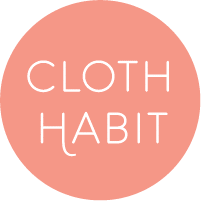
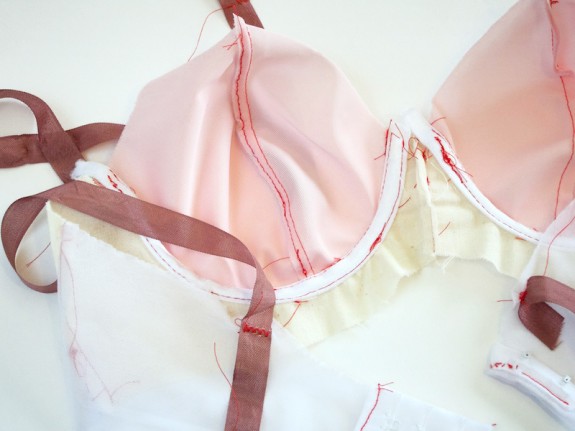
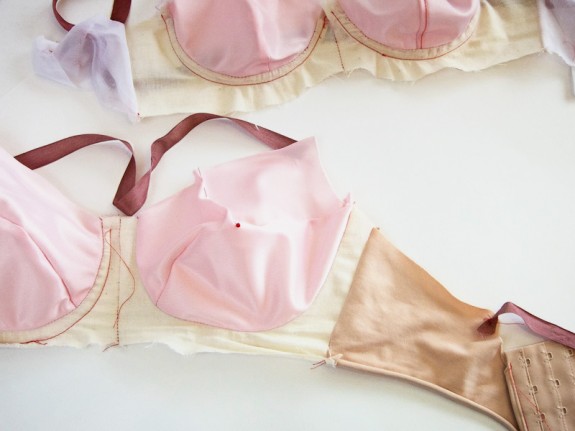

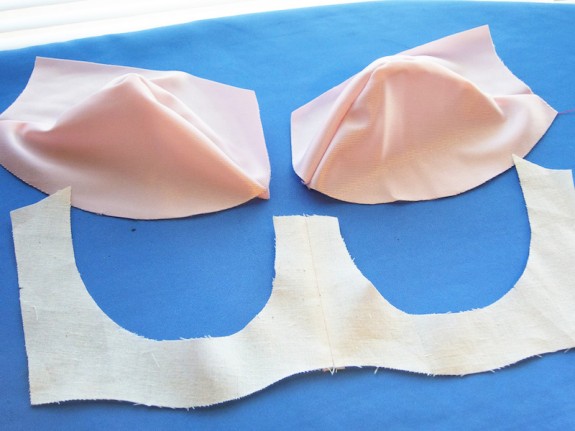
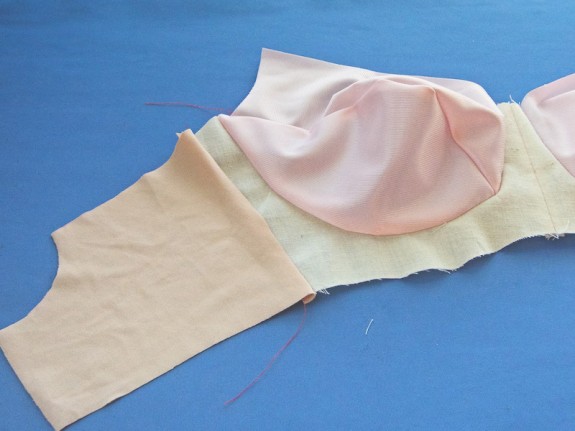

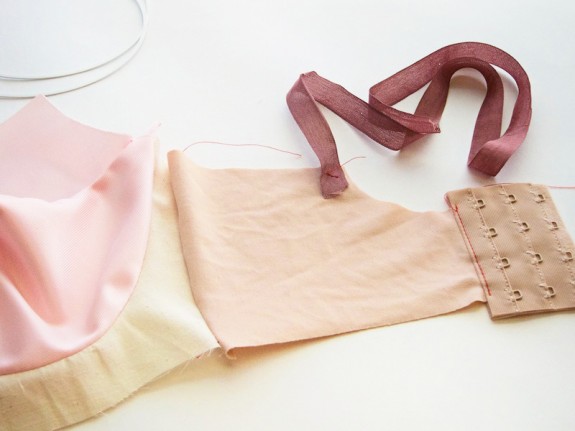
Hey Amy! I just wanted to drop a note and say thank you for all your hard work on the sew along! I’m eyeball deep in a deadline at work so I can’t ACTUALLY sew along – but when I come up for air I’m going to be revisiting all these posts!! Your such a genius with your muslin-ing, I don’t know why I never thought of doing this?!
Hi Sallie, thanks. I never thought of it either! Until I made 3 bras and thought, there has to be a better way to figure it out. Sometimes I just make tester cups and put the wire in–if I already know the cup fits but want to change/visualize the cup shaping.
Hey …actually i am working as a trainee merchandiser for a lingerie factory…cn u tell me plz wat type of stitches are needed and how com i do costing a bra ?
I’m confused as to why cups can be made out of either stretch or non-stretch fabric. How can there be any support with a stretch fabric?
Thanks,
Hi Theresa, good question! Some women prefer stretchy cups. And a lot of the bra kits include cup fabrics with spandex/lycra so I wanted to mention that in case some were planning on using a fabric with stretch. At my size, I can certainly get away with a stretch cup… or perhaps someone that is very self-supporting might, too. But you’re right, for the best lift and support for most women, a non-stretch cup is probably best!
I second Sallie’s comment. Amy, thank you for hosting this sew along. Like Sallie, I’m not partaking but am following along avidly. I’m about halfway through Beverly Johnson’s Bra Making Manual and this is the perfect supplement to it. I get to see everything she write about put into practice!
Isn’t that a great book? The 2nd volume is fantastic as well.
Your “training bras” look great 😉 How did they fit, compared to your expectations?
I have just triple-checked all my seam allowances that I had to add to my Sewy pattern and am cutting it out now. That took me longer than expected – back to kindergarten with me, I guess. I picked my size based on my measurements plus pattern reviews I found online. Mine is a 3 piece cup, which I have never tried but am hoping it gives excellent support. By tomorrow I will have test cups in test fabric – if I dare to use the “good” fabric without a test, I jinx myself.
I hope the fitting goes well! I love that Sewy pattern–3-piece cups are really pretty and offer a lot of shape and support.
I’ll share some about the fit of my trial bras this weekend! And I’ll definitely be posting pictures of them in the Flickr group so you can see all the details.
First of all thank you so much Amy for sharing your knowledge. I have cut everything out and sewn the upper and lower cup together. I am now looking at the amount of ease that needs to be done to get that cup into the cradle – whoa! I have double checked my pattern pieces against the original (Pin up girls classic bra) and all is correct (I photocopy the original so I don’t have to faff around with tracing) and it is an exact copy. The distance between the A and B on the lower cup (38D) is much larger than the distance between the A and B markings on the cradle. I checked against all the cup sizes and cradles and this is so for all of them. I guess i just go ahead and stretch the cradle to fit?? There is about 1cm difference!
Hi Rebecca, hmmm… that’s strange because it isn’t the case on my Pin-up pattern. I wonder why. At least from my experience there doesn’t need to be ease if the cup is drafted correctly. If you want, you can email me the pics of your pattern and I can see what’s going on.
BTW, that’s a really good idea to photocopy your pattern! I did that too so I actually don’t have to keep retracing it when I make a change. I copy it off on card paper so I have a nice thick pattern to work from.
Amazingly it has just sewn together perfectly!! Wrong size 9will try 36D next) but perfect matching.
Great! It may be (and is often the case especially when sewing a convex to concave curve) that the lengths along the seam edges don’t match, but the seamlines do.
Amy, I LOVE the idea of sewing a tester bra! It took all the stress and pressure off knowing I wasn’t trying to make a bra – and a perfect one at that. I was making this to see what else I might need to change. What a relief! And now I know the couple of little changes I still need to make. Thank you!
Great! I’m glad it worked out for you!
Amy,
Your instructions are fabulous!
Just a question – when you make your ‘real’ bra (not the tester), do you use interfacing with the duoplex? My pattern (Danglez DB3E) calls for interfacing. If you do use interfacing, do you have a preferred type?
Thanks,
Andrea
Hi Andrea, thanks! Of all the traditional bra fabrics, Duoplex is the strongest. It barely stretches if at all and is kind of thick. So I would think most people wouldn’t need to interface it if that was their main cup fabric. It really depends on what your main cup fabric is… With most fabrics, a fusible tricot (sometimes called fusible knit interfacing) will do the trick. With others, just a light lining. It also depends on how much support you need. Some of the bra fabrics have some mechanical stretch so to keep the lift, they’ll need lining or interfacing… I need very little support so I just use sheer nylon as a lining! Does that help?
Hi Amy
I just finished my first bra toile. Although there are fitting adjustments that will need to be corrected (just posted my pictures on the flicker page) I’m thrilled to realize the general construction was much easier than I’d ever anticipated. I spent an enjoyable afternoon working through the process listening to my favorite sewing songstress Blossom Dearie. Perfect for spending an afternoon making lingerie. Check it out, I bet you’ll agree 🙂
Hi Amy,
I’m making the Danglez DB4E bra and notice that they line it with interfacing. Is this the same as lining with tricot?
Helen
Hi Helen, fusing interfacing and sewing in a separate tricot lining are different but both are the same routes to the destination–stabilizing your cup. I think this particular pattern suggests fusible interfacing because it also suggests lycra as the main cup fabric. For these cup sizes, if you’re going to use lycra it’s probably best to stabilize it with fusing and remove as much stretch as possible. You could even line it on top of that. Does that help?
Hi Amy thanks for such a brilliant sew along . Up there you mentioned that the bra cradle has to be stable, how important is that? I’m sewing mine in a stretch satin and was hoping to use this fabric for the whole bra with lace over the satin on the upper cup, if I interface it and line the cradle/bridge I should be okay yeah? I made a couple last week that I put on my blog, two I made out of a stretch fabric, I interfaced the top of the cup and lined the whole thing in a soft ( minimal stretch ) tulle and it turned out fab but is what I’ve done kinda wrong even if the fit and feel are great? Yikes!
Hi Kazz, your bras are amazing! Your instincts are right on. Especially by lining with the net. It’s especially important that the cradle area around the cups doesn’t stretch to keep the cups in place and whether you get there by lining or interfacing (or both) is up to you. (RTW bras often use a sheer tricot–which may be what you are using?) For the cups it’s really personal preference and the less stretch the more support. I can get away with a lightweight cup but everyone’s different…
Can I link to your bras? Kazz’s beautiful bras! I love the longline change and adding boning to the side seams. Carry on, girl.
Yay! this is good news I have a habit of throwing the instructions and using my intuition which can sometimes get me into trouble. I never knew they were called longline bra’s. I’m learning 🙂 Beverly’s bra-making manual has just arrived, fun bra-making times to come.
Pretty lingerie, Kazz! Love all the colors.
Kazz – love your sets. Really nice!
I have been searching the universe for powernet, and now that I’ve found it, I have a new question–do I want the “lightweight” or the “heavyweight”? I wear a 42DD at the moment (though I’m sure that will change when my pattern finally arrives…).
Thanks! I’m loving the sew-along and can’t wait to make bras that fit all of my oddities AND don’t kill my back!
Hi Amy! I am very interested in making the trial bra as my first 2 attempts using all the good fabric are still not quite right. How do I find the flickr group to see all the pictures from the bra sewalong and post my own?
Hi Cheryl,
Unfortunately, the Flickr group has been closed for over two years. It was a private group for the original participants. But you are more than welcome to send me pictures via email and I am happy to offer a couple of suggestions. You can contact me here and I’ll get back to you: https://clothhabit.com/contact/
Where can i get a pattern there are no patterns in the normal old fashioned pattern books at least not in South Africa
Hi Barbara, some of the patterns used in this sew-along are no longer available but since then the lingerie pattern scene has changed quite a bit. I definitely recommend buying a bra pattern from a company who specializes in bra patterns if you want modern techniques and contemporary bra drafting. Older books have cute little vintage styles but are not the best in supportive patterns and up to date techniques. Most of bra pattern sellers ship internationally (I buy from Europe into the United States all the time) and many sell digital patterns. While I couldn’t possibly list all the patterns out there, you may want to take a look at my bra supply page to jumpstart your research – https://clothhabit.com/bramaking-resources/